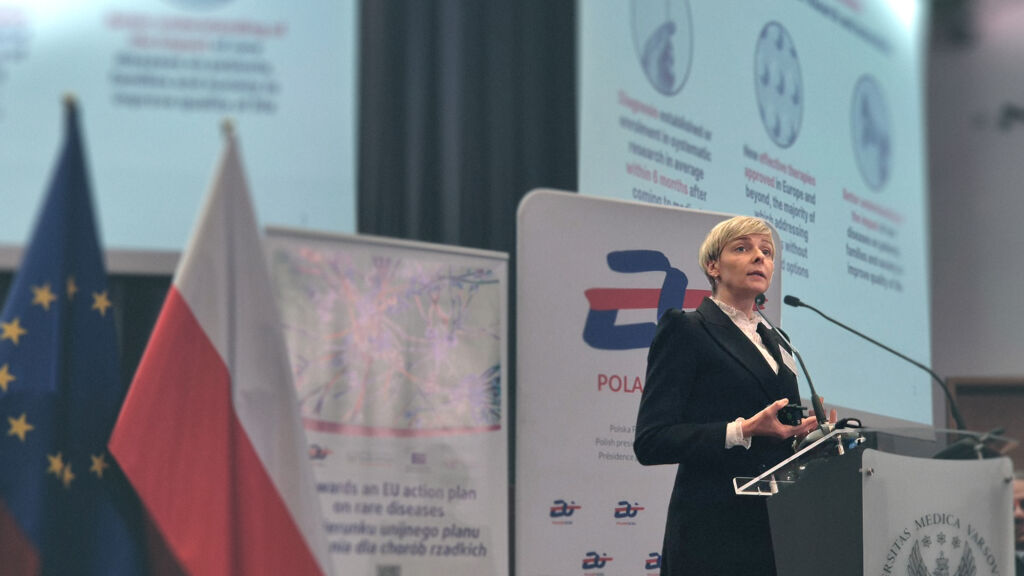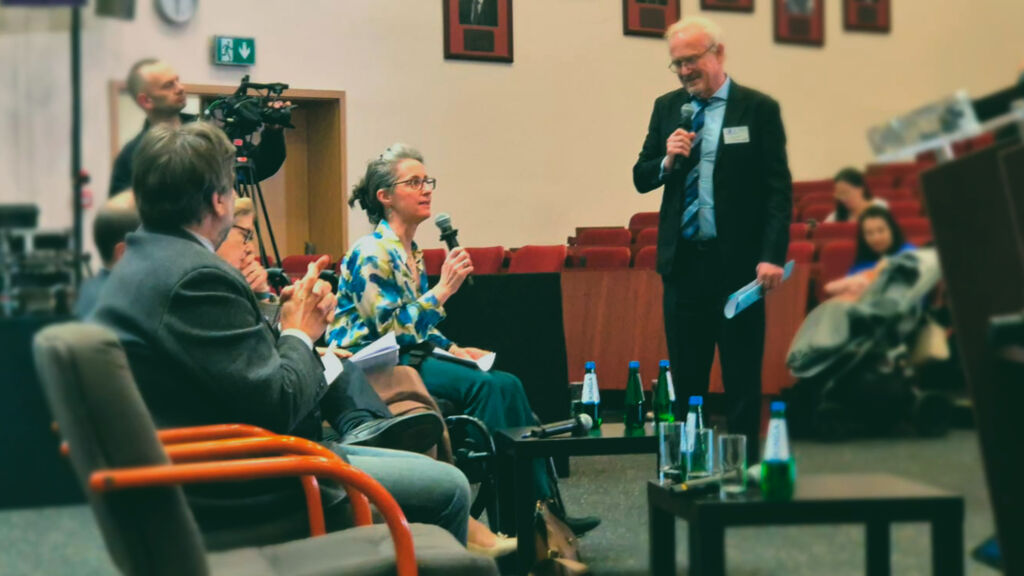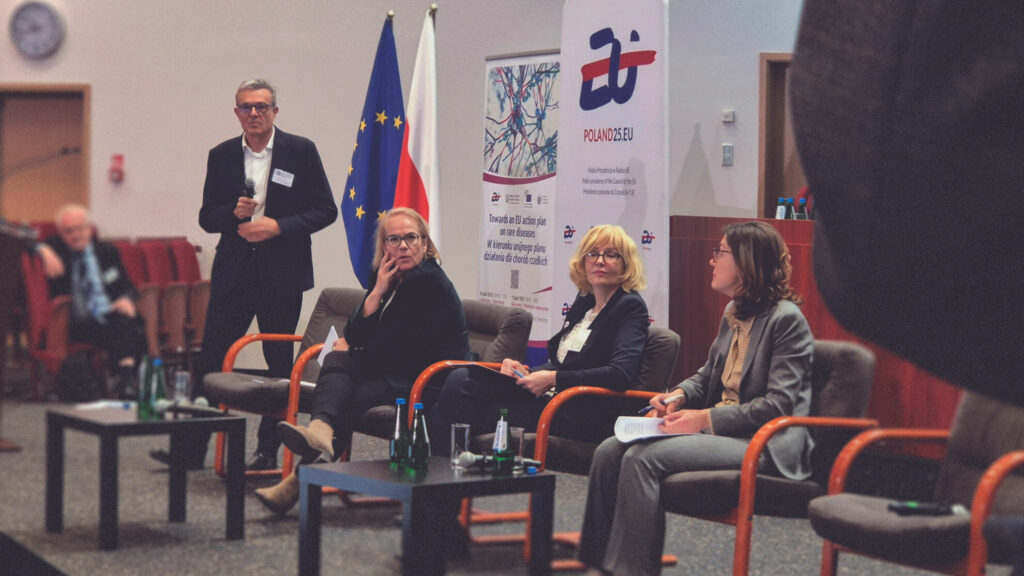Goverment officials, medical experts, patient organisations, and top researchers gathered today at the Medical University of Warsaw for the opening of “Towards an EU Action Plan on Rare Diseases.” Held under the auspices of the Polish Presidency of the EU Council and co-organised by the Polish Ministry of Health, the European Economic and Social Committee (EESC), and the Medical University of Warsaw, the event spotlighted the need for concrete, Europe-wide measures to help people affected by rare conditions.
Morning sessions addressed Poland’s newly unveiled national plan and showcased examples from different countries, illustrating that cross-country collaboration can avert fragmented care. Representatives from the European Commission underlined the importance of a truly pan-European approach, with shared legislation, strategic funding, and harmonised programmes.
Anne-Sophie Lapointe, Project Manager of Rare diseases mission, at the French Ministry of Labour, Health, Solidarity and Families, insisted that “a common EU Action Plan would have the potential for streamlining rare disease efforts from all 27 countries, increasing the link among all EU legislations in matters such as data, pharmaceutical, or medical devices”, noting that it should be prioritised “not for the benefit, but for the policy.”

ERN harmonisation for a streamlined EU Action
Olivér Várhelyi, European Commissioner for Health and Animal Welfare, also highlighted the key role of the ongoing Reform of the EU pharmaceutical legislation in standardising therapies. “It promotes development of treatments for rare diseases through regulatory incentives and free scientific advice, addressing areas where there are no treatment options for patients,” he noted, highlighting the parallel role of the 24 European Reference Networks (ERNs)—collaborations that connect specialised healthcare centres across the EU—in the dissemination of these treatments throughout Europe. “ERNs are unique because they allow expertise to travel,” he said.
Challenges in harmonising the work of the European Reference Networks (ERNs) are being tackled by multiple initiatives, notably the JARDIN Joint Action, which disseminates and integrates ERN findings and treatments into policy and clinical practice across all 27 EU Member States, plus Norway and Ukraine.
Meanwhile, the European Rare Diseases Research Alliance (ERDERA) drives a broader ecosystem in which collaborative research serves as a catalyst for patient support, clinical trials, market inclusion, and transnational harmonization. “JARDIN and ERDERA are like homozygous twins, sharing the same research DNA while each fulfills unique roles to unify Europe’s progress in tackling rare diseases,” said ERDERA Coordinator Daria Julkowska, highlighting the crucial involvement of ERNs in both efforts.
Luca Sangiorgi, Coordinator of the ERNs Coordinators Group, observed that while there are still substantial differences among Member States, harmonization efforts continue to progress. “We have many different systems, and many ways of adapting While discussions about a EU Action Plan are ongoing, some countries still do not have their own,” he pointed out. “Countries should set up common indicators and common stategies that could respond to common needs, and a good monitoring is also essential so that centers are always updated and ready for responding.” On that note, he announced a yearly report to monitor the ERNs’ impact on the rare disease community, with the first issue set for release in May.

Sessions on Ukraine and newborn screening
Afternoon sessions turned a spotlight on Ukraine, which has relied heavily on the Polish—particularly Warsaw’s—health system since the conflict began, with the capital’s population increasing substantially within months.
This was followed by a session highlighting how early newborn screening can revolutionise both diagnosis and care for genetic rare diseases, underscoring the growing relevance of big data in tackling rare diseases. Maurizio Scarpa, Coordinator of the ERN for Metabolic Disorders (MetabERN), noted that “if you detect a child before it presents syntoms, you can treat them with the protein that is missing or the gene therapy -and there are now different ways of correcting the genes or even going to correct the sequence mutation”, something which could have a ripple effect in the knowledge of genomic research and clinical applications. “You can then establish differences between disorders of the same conditions, and prognosis in the family”, he said.
The potential for newborn screening in Europe, however, introduces additional complexities such as interpreting large datasets, ensuring informed consent at scale, and navigating data processing challenges. Echoing previous sessions, participants emphasised the lack of uniformity in implementing these technologies.
Day Two Co-Organised by ERDERA
Tomorrow’s programme—co-hosted by the European Rare Diseases Research Alliance (ERDERA), alongside EURORDIS, Poland’s Medical Research Agency (ABM), and the Polish forum for rare diseases, Orphan—will expand on how to bridge research and patient care. ERDERA, which champions transnational collaboration to boost clinical research, will guide sessions on translational medicine and emerging therapies.
One key milestone will be the launch of Poland’s first National Mirror Group, a country-level forum designed to ‘mirror’ and implement EU goals, strengthening coordination between national stakeholders and European initiatives. Organisers hope this model will inspire other member states to bolster their own rare disease strategies.


